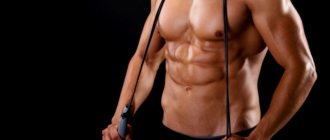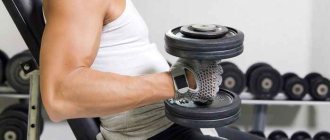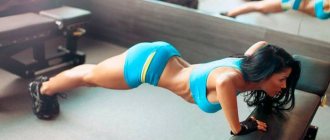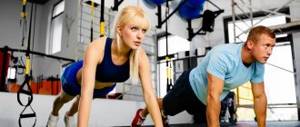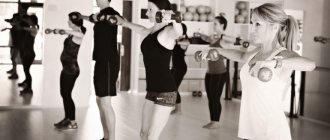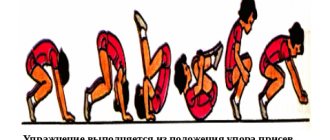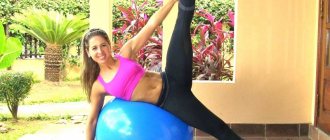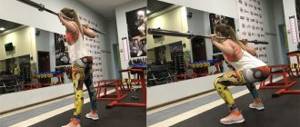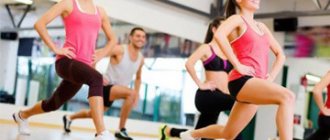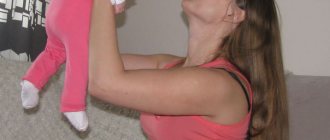Circuit training is a program that involves performing exercises one after another, with minimal break. Functional training, on the other hand, means using bodyweight exercises and movements typical of everyday life.
Below in the material you will find an example of a home circuit training program for men - based on strength functional exercises that can be performed without equipment. The main emphasis is on the muscles of the abs, core, legs and buttocks. The result is muscle strengthening, fat burning and relief definition.
Features of functional exercises for women
Functional training is a universal tool for achieving sports goals (improving various areas, losing weight, achieving flat abs).
Specific features of such training include:
- Each muscle is considered here as an important element - that is why a sufficient number of isolation exercises are used (certain muscle groups are purposefully pumped).
- Increased intensity of exercise to increase the overall endurance of the whole body.
- The desire for proportional development of all muscles.
- A wide variety of auxiliary equipment: a variety of exercise equipment, sports balls, jump ropes, crossbars, barbells, weights, elastic bands, etc.
- The use of various exercises that are widely known in the sports world.
- It is possible to train not only in a specially equipped room, but also on the street, at home.
- It does not take much time - the duration of a standard lesson is from 40 to 60 minutes.
Note! The main rule of such training, which is true for women's and men's training, is the consistent inclusion of all muscle groups in the work.
Full body complex for beginners for a month by week
At home
Functional exercises can be done at home.
To do this, you will need an exercise mat, weights (dumbbells or bottles filled with water), a jump rope, and a stable chair/armchair should be used as a support.
Note! The exercises are performed at a fast pace, the break between individual ligaments is no more than 60 seconds.
Outdoors (in the park, at the stadium)
Exercising in the fresh air can increase the effect of your usual functional training. On the street or stadium, you can use existing parallel bars and horizontal bars for intense muscle load.
In the gym
In special conditions, functional training can be as varied as possible - all kinds of exercise machines, dumbbells, barbells, fitballs, etc. are used.
Cardio workouts can include running on a treadmill, riding an exercise bike, or warming up on an orbital track.
Example training program:
How to create the best individual comprehensive fitness plan for all muscle groups
Preparing an effective lesson plan should include the following steps.
- The main objective. There are 5 main options: increasing muscle mass, losing weight, increasing strength, working on relief, maintaining athletic shape. Achieving several goals at the same time is difficult to achieve (for example, you cannot lose your belly and increase your biceps at the same time). Work on the body should be gradual: for example, it is first recommended to pump muscles (increase their mass), and then a gradual process of losing weight (drying).
- Number of classes per week. This indicator depends on your goal and capabilities (free time, financial component, well-being). If you are focused on maintaining shape, you need 2 classes per week, when working on mass and/or strength indicators - 2-3 classes, when losing excess weight or doing terrain loads, you need at least 3 workouts per week.
- Methods for implementing exercises. The most popular are: separate, supersets, circular and combined. Each method is effective for different purposes. For example, it is better to burn fat using supersets or circuit training, and gain weight using separate approaches.
- A set of exercises. To begin, sort the exercises by target muscle groups. The number of ligaments may vary depending on the focus of the training. If you exercise twice a week to stay in shape, 10 exercises are enough (5 for each session).
- Load distribution. When gaining weight, you need to work no more than 1-2 muscle groups in each workout. When losing weight, on the contrary, you should use as many muscle groups as possible for intense fat burning processes.
- Execution order. This moment affects the quality of the training and the final result. For example, first there is a warm-up, then basic exercises with free weights, and only after that exercises on machines that isolate loads.
- Number of approaches and repetitions. Directly affects the intensity of exercise - as the number of repetitions increases, calorie consumption increases. For this reason, a minimum number of approaches and repetitions (3×8-10) is recommended for gaining weight, and much more (5×15-20) when losing weight.
Lunge and scissors
After performing a lunge with a step forward, with a quick movement we do “scissors” (changing the position of the legs) twice, after which we perform a lunge with the other leg. An explosive exercise aimed at increasing the intensity of the session. It is also possible to perform timed approaches (30-45 seconds), 3-4 approaches with a rest of 15-30 seconds between them.
Exercises can be performed either using the standard approach method (this is when each exercise is performed several approaches with rest, and then moving on to the next exercise), or the circuit method. A certain sequence of exercises (circle) is compiled, each is performed for 30-45 seconds, after which the transition occurs to the next exercise (10-20 seconds). When forming a circle, it is desirable that it contains an exercise for the muscles of the legs, upper body, abdominal muscles and one jumping exercise. In one workout you can perform from 3 to 5 circles with a 1 minute rest between them.
By studying at home using your own designer, you can always change something in your classes. It is worth remembering that after some time your body will get used to certain exercises, so the complex will still have to be complicated or rebuilt. Have fun!
Expert advice
I. Timko, sports expert, personal fitness trainer
I have a somewhat negative attitude towards writing training programs on my own - quite often beginners approach this matter too frivolously. But it is quite obvious that not everyone is able to pay for the services of a personal trainer. There are also those who fundamentally intend to draw up a lesson plan for themselves, or who simply do not have an intelligent instructor nearby.
On topic: Championship manager 03 04 no training
Anyone can write their own exercise plan if they have a little training experience. First of all, you should focus on performing the exercises correctly (choose only those whose technique you are familiar with). Also, do not forget about proper rest between classes - while adapting to stress, the body needs a balanced diet and quality sleep (at least 8 hours).
V. Mayorov, CMS in powerlifting, professional bodybuilding instructor
A functional training plan primarily prepares your body for various everyday stresses, activates muscles, increases endurance and overall flexibility. Such training should not cause pain or significant physical discomfort.
For optimal results, be sure to warm up all joints and ligaments before your next session - proper and sufficient warming up will help avoid possible injuries. If you have not trained before, I advise you to undergo a medical examination to check for any special contraindications.
R. Panov, instructor of the X-Fit fitness club, personal trainer
Exercises that are worked through during functional training help “harden” the body and improve overall well-being at any age. Also, to start training, your level of physical fitness is completely unimportant - muscle pumping will occur gradually (so that the body has time to adapt to new loads).
Beginners can train without any weights or additional equipment; increasing weight is only necessary for further progress. In a gym setting, you can also use TRX loops, chains, etc. The more varied your sports activity, the better for the final result.
Main conclusions
A competent approach to physical training requires drawing up a training plan. This program is based on:
- Choosing a specific sports goal (losing weight, pumping target muscles, working on a sculpted body, maintaining training results, etc.).
- Number of sports training sessions per week.
- A variety of exercises and a certain sequence of loads.
Writing a physical activity program requires some experience and theoretical knowledge. At the first stage, a beginner should follow the advice of a qualified trainer.
Source
Functional training
Are you starting a fitness routine or recovering after a long break? Or maybe your goal is to achieve success in sports that are difficult to coordinate? Incorporate functional training into your schedule. About its capabilities - article “K&Z”.
What is functional training
Functional training (FT) is an innovative approach to general physical training (GPP). It is believed that it contains the best for the multifaceted development of the body that the fitness industry has to offer in principle. PT strengthens muscles (including deep ones) and adapts our body to various loads. It develops strength, endurance, coordination, balance, flexibility - physical qualities necessary in everyday life.
Instructors in clubs value functional training for its lack of attachment to specific equipment - classes are conducted with your own weight or with any accessories such as fitballs, dumbbells, weights - plus the ability to combine exercises. The latter advantage allows you to significantly diversify the training process, creating a positive psycho-emotional tone of the body and increasing motivation.
The essence of functional training
Functional training involves short but intense training. The priority is the result, not the process itself. During anaerobic training - this includes PT - calories are readily consumed (not only carbohydrates, but also fats) and muscle mass actively increases.
The main principle of functional training is naturalness of movements. The exercises are simple and familiar. There are six main groups: squats, walking (lunges), body extensions, body rotations, presses (movements away from the body) and rows (movements towards the body).
Any PT training involves performing exercises from all six groups - at least one from each. Work out according to the classical scheme, performing exercises one after another, or according to the principle of circuit training - after completing one set of the first exercise, move on to the second and so on until the last, completing the first cycle. Then - a new cycle from the second approach of the first exercise and further. To develop stabilizer muscles and train the vestibular system, it is important to exercise in unstable positions (standing on one leg or using only one hand) and on unstable platforms (bosu, core board, indoboard).
Types of functional training
One of the types of functional training is core training (from the English core - center). The core is the collection of muscles surrounding the abdominal cavity, a critical internal stabilization system that includes the diaphragm, spinal stabilizer muscles, pelvic floor muscles, and abdominal muscles. Every time you lift an object, push, throw, jump, walk, or simply lie down, your core is active—it stabilizes your core and maintains your posture. Training it is especially important for developing coordination, increasing strength results and in order to prevent injuries.
You can exercise either on a special unstable platform or without it, with strength and dance elements. The mission of core training is to force the body to maintain balance. Moreover, this is only possible with uncomfortable exercises. However, it is quite possible to strengthen your core even while standing still! How exactly? Turn the page. We have prepared a master class for you.
Six groups of PT exercises
1. Squats
Squats with trunk rotation and medicine ball press
This combination of movements engages the muscles of the legs, core, lower back, chest, shoulders, triceps and promotes active fat burning. Stand straight with your feet shoulder-width apart or slightly wider. Take the medicine ball in your hands and place it near your chest. Lower yourself into a squat, holding the ball in the starting position, then stand up. When lifting, sharply turn your body to the right and extend your arms with the medicine ball forward. Return to the starting position and repeat the exercise on the other side. 2. Walking (lunges)
Bulgarian lunges
A complex coordination exercise that involves the muscles of the thighs and buttocks. Place a step platform in front of you. Stand with your back to it and take your right leg back, placing your toe on the platform. Bend your left leg at the knee and lower yourself down until your thigh is parallel to the floor. Then return to the starting position and repeat. Make sure that the knee of the supporting leg does not extend beyond the foot.
3. Extension of the body
Swings with a kettlebell
This exercise is great for expending energy and strengthening the muscles of the lower back, buttocks, hips and shoulders. Stand straight with your feet shoulder-width apart. Take a weight in your hands and place it in front of you between your legs. Push your pelvis back and bend your legs, lowering yourself into a half-squat position. Holding the kettlebell in straight arms, swing it towards you. Using the pendulum effect that has arisen, straighten up and lift the weight to chest level. Then slowly lower it and return to the starting position. Repeat.
4. Body turnsLumberjack
The exercise develops the abdominal muscles with an emphasis on the oblique abdominal muscles.
Stand with your side to the top block. Place your feet shoulder-width apart, bend your knees slightly. Grasp the block with your closest hand, wrapping your other hand over your hand. With straight arms in an arc, make a chopping movement with maximum amplitude, lowering the handle downwards. Then return to the starting position. Remember, the range of motion should be maximum. After completing the repetitions, stand on the other side of the block and repeat the exercise.
5. Presses
Shock absorber press with a partner
The exercise is particularly effective at working the pectoralis major muscle. You will need two rubber expanders. Take one handle in each hand (fists at chest level), let your partner take the other two ends, standing behind you. Step back enough to feel the tension on the expander. Straighten your arms in front of you, performing a press. The partner’s task is to change the tension by abducting, adducting and pulling the expanders with different strength and speed for each hand. Your task is to do bench presses.
6. Pulls
One-arm dumbbell row while standing on one leg
One of the most difficult exercises, it develops the muscles of the core and back, and trains coordination. Take a dumbbell in one hand and stand straight. Place your arms along your body. Lean forward at a 45° angle. Lift one leg off the floor and walk it back. Pull the dumbbell to your waist, bending your elbow. Then lower it to the starting position. Repeat and then switch arms and legs.
Functional training for fast weight loss
The popularity of functional training is growing exponentially. They are accessible, intuitive, varied and effective. This discipline draws a parallel between sports and everyday life practices. With the types of physical efforts that we put in every day (bending, squatting, turning, etc.). These are basic actions and loads, which means you can handle them without difficulty!
The movements you make while cleaning, climbing stairs, playing with children or cooking are simple and natural. Could this mean that they cost us nothing? No! And such activity requires coordination, balance, flexibility and strength. Think about how you move through fresh snow or ice. In the first case, you need to raise your legs a little higher, in the second - balance.
Functional training is aimed at developing not only large and visible muscles, but also small stabilizer muscles.
Such muscles are located deeper and are the support for the body and the starting point of each process. Their pumping is not controlled at the psychological level. This means that you cannot concentrate on it (as in programs for large and visible muscles).
What is functional training?
Functional training is a training session aimed at teaching the simplest motor movements, developing physical qualities, and improving the physique.
These workouts should be tailored to your fitness level.
In addition, before starting a training session, you should definitely consult your doctor.
You should not force physical activity, as this can lead to bad consequences.
Initially, these training sessions were used only by professional athletes.
A couple of years ago they began to be actively introduced into the program of fitness clubs. The predecessor of this training was Pilates.
It was proposed to perform the standard abdominal crunch slowly, as a result of which the stabilizer muscles, which are responsible for posture, were activated.
Even experienced bodybuilders are exhausted at first from such non-standard physical activity.
The point of the training is to practice body movements necessary in standard life: sitting at a table or in a chair, jumping over puddles, lifting and holding weights in your hands, etc.
This helps improve the strength of the muscles involved in these body movements.
The simulators allow you to perform body movements not along a fixed trajectory, as with standard equipment, but along a free one.
As a result, the muscles move and function as they do in life. Such exercises are extremely effective.
The main feature is that when performing functional physical exercises, all muscle groups without exception are activated, including deep ones, which are responsible for the stability of our body movements.
This training makes it possible to successfully develop all basic physical qualities. Functional training allows you to achieve harmonious development of the whole body.
The proposed training is so highly effective that it was included in a special physical training program for military personnel.
But this does not mean that it cannot be performed by girls in the gym or at home.
5 Healthy Benefits of Functional Training
- Such a workshop improves all fundamental physical qualities. This means that functional training develops flexibility and agility, strength and aerobic endurance, coordination and speed at the same time.
- Develops skeletal muscles. Harmoniously and balanced loads all muscle groups. Dynamically engages stabilizer muscles.
- Improves body appearance. Burns fat, builds beautiful “lean” muscles.
- Improves health and speeds up metabolism. Motivates you to get rid of bad habits and eat smarter.
- Expands the sports range. Such training involves a wide range of exercises and equipment used.
Such intense training helps burn calories. During prolonged exercise, accumulated fat acts as an energy source, which promotes fat burning. Another bonus is the increase in muscle mass, which makes the body more toned.
Functional training for women and what are their features
Recently, functional training has become increasingly popular. What is its feature? Functional training involves performing exercises that we encounter every day: climbing stairs, carrying heavy objects, and so on. This style of training can be either independent or used as a supplement to the main training.
The point of the functional method is not to increase the load on the body, but to diversify the set of exercises and force muscle groups to move along new trajectories.
For functional training, both improvised means and special simulators that imitate natural body movements can be used. The main advantage of such equipment is that it creates an optimal level of load on the entire musculoskeletal system, which allows you to distribute tension evenly throughout the body and effectively burn fat deposits.
Who is this type of activity suitable for?
Functional training is a universal system for people of any age and level of training. You can exercise at home and in the gym. At home, you will be limited only by the lack of necessary equipment (rubber shock absorbers, unstable platforms, balls, body bars, dumbbells, etc.). Will this mean that you will not be able to achieve the desired effect? No! A lot of techniques have been developed that do not require any equipment at all.
These workouts are ideal for general physical fitness. They strengthen muscles, destroy fat reserves, develop endurance, and contribute to the acquisition of an athletic appearance.
Functional training for losing weight and building massive muscles
The vast majority of women who choose the functional method dream of getting rid of extra pounds. Such training (especially at a high pace) really promotes the active burning of fat deposits. This also happens due to the acceleration of metabolism.
It should be remembered that to achieve noticeable results you need to train at least three times a week. One or two workouts in seven days do not guarantee serious metabolic changes and a noticeable reduction in body fat. The duration of the workout should be from twenty to sixty minutes. We must not forget about such an important detail as balanced nutrition.
By the way, here is one of the options for functional training for weight loss:
Functional training is about energy, not strength and muscle mass. What could this mean? This type of training cannot be called the optimal tool for muscle development. An increase in muscle mass will be noticed only by those who have not previously resorted to weight-bearing exercises at all.
Full body workout – getting your whole body in order
For those representatives of the fair sex who have just started training on weight loss machines, it is best to create a set of exercises so that they work out the whole body in one trip to the gym. Split training will only be effective if all your muscles are sufficiently developed and you want to highlight a specific group.
Fullbody workouts are also convenient because they allow you to recover if you miss one session. Let's take a closer look at the basic set of exercises for the whole body:
- The deadlift is an exercise that targets major muscle groups. Start doing deadlifts only with an empty bar and under the supervision of a trainer, gradually increase the weight. It is recommended to perform the exercise no more than 2 times a week.
- Squat with weights. In this case, you can use a barbell on your shoulders or dumbbells. This is an effective workout for the legs and gluteal muscles. If you want a beautiful butt, then do as deep a squat as possible. Perform this exercise no more than 2 times a week.
- Bench press, dumbbell fly, or push-ups - all these exercises effectively work the chest and biceps muscles. In the initial stages, it is recommended to train your chest no more than once a week.
- Weighted Lunges – Use dumbbells or a barbell held on your shoulders.
- The plank is one of the best exercises for women, which allows you to work not only the abdominal muscles (rectus and lateral muscles), but also use your back.
15 repetitions for each exercise is the maximum threshold in the initial stages; for the plank, 3 sets of 30 seconds are enough. If you follow all the techniques and practice regularly, you will achieve good results very soon.
More experienced athletes who want to gain muscle should:
- reduce the number of workouts to two per week;
- adjust the complex in favor of strength sessions with your own weight and movements with weights;
- do not overestimate the number of repetitions in the approach (12-15 is enough);
- follow a high protein diet.
Functional training is excellent for getting a lean and lean body. And for power, turn to the relevant disciplines. But this does not mean that functional training for the full development of the body is not suitable for you.
Is functional training exhausting?
There is a myth that functional training is necessarily high-intensity, grueling training. This is a fairly common misconception, because exercises can be selected individually for a person with any level of training. Moreover, in the arsenal of trainers there is a wide variety of “leading” exercises, with the help of which you can teach a person to perform any, even the most complex, movement. By the way, progression in functional training will primarily consist not in increasing weights, but in complicating the movement itself and integrating various elements into one exercise.
Photo: istockphoto.com
